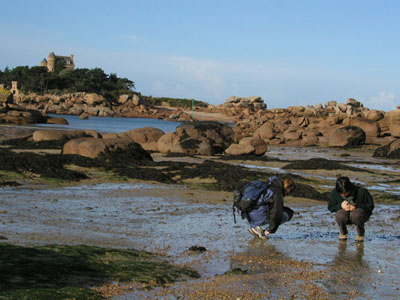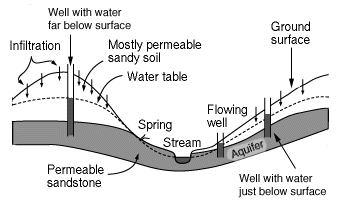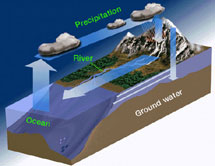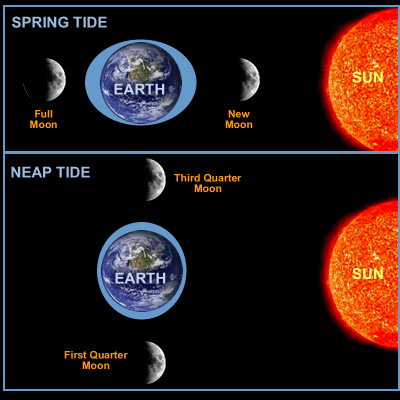The relative location of the Moon and Sun during spring and neap tides. In this diagram, an exaggerated blue ocean around the Earth shows high tides as a thick bulge.
Click on image for full size
Windows to the Universe / Lisa Gardiner
Tides of the Ocean
If you sat on an ocean beach for many hours, you might notice that water covers more of the beach at some times than at other times. This happens because the ocean surface rises and falls – a phenomenon called tides. The highest point of the rise is called high tide. The lowest point is called low tide. Most places have two high tides and two low tides each day.
Tides happen because of the pull of the Moon and Sun on ocean water. The Moon has a much greater impact on tides than the Sun because it is much closer. The Moon's gravity pulls water that is closest to it making a high tide on the side of the Earth closest to the Moon and there is a high tide on the opposite side of the Earth too. Low tides happen in places between the high tides.
The difference between high and low tide can be as little as a few centimeters to as much as several meters depending on the shape of the ocean floor. In Canada's Bay of Fundy the tidal range is very large – 16 meters.
At times when the Sun, Earth, and Moon are in line with each other, the tidal range is larger because both the Sun’s and Moon’s gravitational pull create the tide. This is called a spring tide. At times when the Moon and Sun are not in line with Earth, when they are at right angles when viewed from Earth, the tidal range is smaller. This is called a neap tide.
Tides are a powerful force. Scientists and engineers are looking for ways to use some of that power to make electricity using turbines. Scientists are studying tidal ecosystems to understand how they might be affected by turbines to make sure that wildlife is not harmed.
Last modified September 18, 2008 by Lisa Gardiner.
You might also be interested in:

The intertidal zone is the area along a coast that is underwater at high tide and above the water at low tide. Creatures that live in the upper part of the intertidal zone are only covered with water during
...more
Looking for online content that can be used for a climate change education course or module? Pages linked below can be used to support an introductory climate change education for either a unit or a full
...more
An aquifer is the name for a layer of rock which is capable of holding a large amount of water. Some layers are better at holding water than others, for example a layer of sandstone can hold a good deal
...more
Limestone is an example of a carbonate. Other examples of carbonates include calcite, dolomite, and marble. Limestone dissolves easily in rainwater, especially rainwater which is loaded with carbonic acid.
...more
Have you ever left a glass of water out for a long time? Did you notice that the water disappears after a few days? That's because it evaporated! Evaporation is when water passes from a liquid to a gas.
...more
The water at the ocean surface is moved by powerful wind. The wind is able to move the top 400 meters of the ocean. This moving water is called surface ocean currents. Surface ocean currents form large
...more
Rivers are very important to Earth because they are major forces that shape the landscape. Also, they provide transportation and water for drinking, washing and farming. Rivers can flow on land or underground
...more















